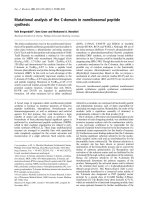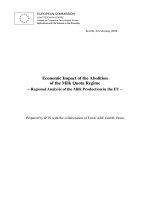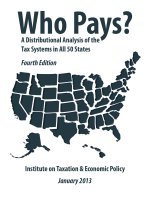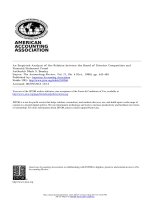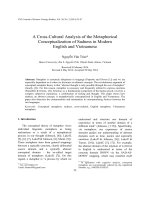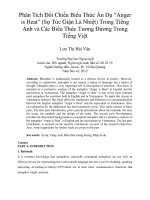Analysis of the management and using the working capital in ltd hùng hà
Bạn đang xem bản rút gọn của tài liệu. Xem và tải ngay bản đầy đủ của tài liệu tại đây (550.91 KB, 54 trang )
HUE UNIVERSITY
COLLEGE OF ECONOMICS
THE ADVANCED PROGRAM
------------------
UNDERGRADUATE THESIS
ANALYSIS OF THE MANAGEMENT AND
USING THE WORKING CAPITAL IN LTD. HÙNG HÀ
TRẦN THỊ HUYỀN TRANG
Academic year 2010 - 2015
HUE UNIVERSITY
COLLEGE OF ECONOMICS
THE ADVANCED PROGRAM
------------------
UNDERGRADUATE THESIS
ANALYSIS OF THE MANAGEMENT AND
USING THE WORKING CAPITAL IN LTD. HÙNG HÀ
Name of student:
Name of supervisor:
Trần Thị Huyền Trang
Lê Tô Minh Tâm
Class: K44-Agricultural Economics-Finance
Academic year: 2010 - 2015
Hue, June 2015
Thanks
The school and the family always wants us to study, research and effectively
applied to practical life. Work completed thesis was initially experiment on combining
theory and practice in the university environment, the personal effort and the help of
many people. So the result has been the economic bachelor thesis following is
indispensable the most sincere gratefulness.
First of all, I would like to thank my teachers in school Hue University of
Economics, thank the teachers teaching with useful knowledge and valuable
experience applied to the subject and above all the riches knowledge baggage for us
on the way of my career.
In particular, I would like to thank to Mr. Truong Quang Dung - who directly
guided me throughout the process of thesis with words of enthusiastic comments.
Thank leadership in Hùng Hà that provided an opportunity for me to practice at
the unit; Thank , accountants who helped me so much during practicing and collecting
documents for research subjects.
Đồng Hới, June 2015
Student
Trần Thị Huyền Trang
INDEX
Trang
INTRODUCTION......................................................................................................................6
Chapter 1:
RATIONALE FOR THE USE OF WORKING CAPITAL
IN ENTERPRISES...................................................................................................................10
1.1. Working capital in enterprises........................................................................................10
1.1.1. The concept and characteristics of working capital in the enterprise.....................10
1.1.2. Characteristics of working capital...........................................................................11
1.1.3. Classification and structure of of working capital..................................................12
1.1.4. The role of working capital.....................................................................................15
1.2. Efficiency use of working capital..................................................................................16
1.2.1. The concept of efficiency in working capital..........................................................16
1.2.2.1. The objective factors........................................................................................16
1.2.2.2. The subjective factor........................................................................................16
1.2.3. A means of enhancing efficiency in working capital..............................................17
1.2.4. The evaluation criteria efficiency using in working capital....................................18
1.2.4.1. Rotated speed of working capital.....................................................................18
1.2.4.2. The level of savings working capital...............................................................18
1.2.4.3. The level of undertake in working capital........................................................19
1.2.4.4. The rate of return of working capital...............................................................19
Chapter 2:
THE STATUS OF MANAGEMENT OF WORKING CAPITAL
AND EFFICIENT USE OF WORKING CAPITAL
IN HÙNG HÀ LTD...................................................................................................................20
2.1. General overview of company, Ltd. Hùng Hà...............................................................20
2.1.1. The process of formation and development of the company..................................20
2.1.1.1. Outline of the formation and development of the company............................20
2.1.1.2. Functions and duties.........................................................................................20
2.1.2. Generalizing business and production activities of the company in 3 years...........20
2.1.2.1. Labor situation.................................................................................................20
2.1.2.2. Situation of assets, capital................................................................................17
2.1.2.3. Results of business activities ...........................................................................20
2.1.3. Organization of the managerial apparatus in company...........................................21
2.1.2.1. Diagram of organization of the managerial apparatus in company.................21
2.1.2.2. The functions, duties and power s of the constituent parts of the company's
managerial apparatus.....................................................................................................21
2.2. Administrators in working capital and efficiency using working capital in Hung Ha
Ltd.........................................................................................................................................24
2.2.1. Composition and structure of working capital in company....................................24
2.2.1.1. Structure of working capital in total capital of business..................................24
2.2.2.2. Structure of capital items in total equity of business.......................................25
2.2.2. Analyzing the situation ensuring the capital for business operations.....................26
2.2.2.1. Capital financing situation of Companies over 3 years...................................26
2.2.2.2. The ratio WC/Short - term debt........................................................................28
2.2.3. Administrators of working capital in company.......................................................29
2.2.3.1. Administrators of capital in cash......................................................................29
2.2.3.2. Administrators of inventories...........................................................................33
2.2.3.3. Administrators of accounts receivable.............................................................37
2.2.4. Efficiency using in working capital in Company....................................................39
2.2.4.1. Rotated speed of working capital.....................................................................40
2.2.4.2. The level of savings working capital...............................................................40
2.2.4.3. The level of undertake in working capital........................................................41
2.2.4.4. The rate of return of working capital...............................................................41
Chapter 3:
INTEGRATED ASSESSMENT AND SOME METHODS IN
ORDER TO ENHANCE THE MANAGEMENT AND USING
THE WORKING CAPTITAL IN HÙNG HÀ LTD..................................................................43
CONCLUSION.........................................................................................................................48
REFERENCE LIST..................................................................................................................49
THE LIST OF TABBLE
Trang
Table 2.1: Labor situation and average income year 2010, 2011, 2012, 2013, 2014................16
Table 2.2: Situation of assets, capital in 2010, 2011, 2012, 2013, 2014 ..................................18
Table 2.3: Results of business activities over 5 years 2010, 2011, 2012, 2013, 2014..............20
Table 2.4: Structure of working capital in total capital of business
in 5 years 2010, 2011, 2012, 2013, 2014..................................................................................24
Table 2.5: Structure of capital items in total equity
of business over 5 year 2010, 2011, 2012, 2013, 2014.............................................................25
Table 2.6: The situation of capital financing in 5 year 2010, 2011, 2012, 2013, 2014.............26
Table 2.7: The ratio WC/Short - term debt in 5 years 2010, 2011, 2012, 2013, 2014..............28
Table 2.8: Solvency of Hùng Hà Ltd. Company.......................................................................31
Table 2.9: Structure of inventory in total inventory of Hùng Hà Ltd. Company......................33
Table 2.10: Structure of receivables in total receivables of the company.................................38
Table 2.11: Efficiency using in working capital in Company...................................................40
INTRODUCTION
Today, in the market economy, the demand for capital for each business becomes
more important and urgent because the enterprises directly faced with the volatility of
the market, with competition from the domestic enterprises and foreign customers
should require the use of capital so that reasonable to provide high efficiency in
production and business activities and increase its competitive strength.
Enterprises operating under the independent accounting methods, to financial
autonomy and is responsible of the results of its operations to profitability for the
business. To achieve this any production business enterprise would need to pay
attention to the issue of capital, how to use and manage their capital to determine the
existence and development of enterprises.
Therefore, significant capital is very important in analyzing business operations
in order to assess the use of corporate capital to achieve superior results at lower cost.
Also on this basis provides useful information for the objects, such as investors, credit
institutions .. Identify actual financial situation for effective investment decisions.
The purpose of the enterprise to participate in the production process that is
headquarters of the key benefits that are profitable. The crux of the matter is the
working capital (WC), WC is the key factor to make a profit for each business. It
directly impacts the daily, hourly everywhere during business activities of the
enterprise, as a condition for implementing enterprise-scale expansion, technical
innovation, improve living standards for workers, and improve its position in the
market. Stemming from the role and importance as well as the practical requirements
for the efficiency of the use of corporate WC, the research to identify /solutions to
improve the efficiency WC always become issue necessarily contribute to ensuring the
survival and development of enterprises long upstairs.
During practice the actual survey process in Hùng Hà Ltd Company of. I noticed
that companies are having difficulty in working capital issues, especially in the
Undergraduate thesis
Supervisor: Trương Quang Dũng
management and use of WC. Here are the problems the company is interested in:
The company established in conditions not much equity capital, to serve the
production needs of business, need large amounts of capital beyond the company's
ability to borrow from banks to other credit institutions. With its big loan amount, as
financial expenses (interest expense high). This large effect on the efficiency of
production and business operations of the Company.
Due to the small size of the company is not focused on managing an effective
way of working capital which saw profit trends are made, there are benefits only bring
immediate but then it did not carry to be effective as it expected enterprise, which is
also the cause of the working capital of the business is stagnant.
Stemming from reality and perception is required after some time requires
graduation exercises in Hùng Hà Co. Ltd., with the help of instructors, I choose the
topic "Analysis of the management and using the Working Capital in Ltd. Hùng Hà "
to do thesis, with the desire to apply the knowledge learned in practice to analyze the
efficiency of capital in Hùng Hà Limited Company in the future.
- The overall objective of this study is to analyze of the use of the Working
Capital in Ltd. Hùng Hà in last 5 years. Since then propose measures to apply to use of
working capital in a most efficient, profitable and beneficial to the company.
- The Specific objectives is
To analyze proportion of working capital in total capital in the company.
To assess the status of the working capital efficiency of the company in the last
5 years.
To analyze, synthesize and evaluate the results achieved and the remaining
face in managing working capital in the company.
To learn the factors affecting working capital.
To illustrate the administration of working capital in the company.
- The scope of research
Subjects of the research: Research focused on capital efficiency in enterprises
Scope of the study:
Time research: The use of capital operation business productivity over the
years 2010-2014.
Name of student: Trần Thị Huyền Trang
7
Undergraduate thesis
Supervisor: Trương Quang Dũng
Space: At Ltd. Hùng Hà.
Methodology
- Data collection
+ Business statement
+ The balance sheet, statement production and business activities, the detailed
records, contracts ... and operational characteristics in the company.
- Data Analysis
1. Rotated speed of working capital
Number of times rotation in WC
Formula: L =
M
WK AV
Note: L is number of times rotation in WK in the period.
M is the total circulation of capital (or net revenues) in the period
WKAV the average working capital in the period and is calculated as follows
WK AV =
V q1 + V q 2 + V q 3 + V q 4
4
Vdq1
Or
WK AV = 2
+ Vcq1 + Vcq 2 + Vcq 3 +
Vcq 4
2
4
Vq1 , Vq 2 , Vq 3 , Vq 4 : the average working capital in quarter 1,2,3,4
Vdq1 : working capital in started of the first quarter
Vcq1, Vcq2, Vcq3, Vcq4 : working capital in the end of quarter 1,2,3,4
Rotated period in working capital
Formula: K =
N
L
Or
K=
WK AV × 360
M
Note: K is rotated period in WC
WCAV is average WC in the period
M is total circulation of capital (or net revenues) in the period
Name of student: Trần Thị Huyền Trang
8
Undergraduate thesis
Supervisor: Trương Quang Dũng
N is number of date ( 360 days/year, 90 days/quarter, 30 days/month)
2. The level of savings working capital.
Formula: M S =
M1
( K1 − K 0 )
360
Or
MS =
M1 M1
=
L1
L0
Note: Ms is the level of savings WC
M1 is total circulation of capital (or net revenue) reporting period
K1, K0 is circulation of capital period plan period, reporting period
L1, L0 is number of revolutions plan period, reporting period
3. The level of undertake in working capital.
Formula: The level of undertake in WK=
WK AV
NR
Note: WKAV is average capital in the period
NR is net revenues in the period
4. The rate of return of working capital
Formula: The rate of return of WK=
TP
WK AV
Note: TP total profit before tax or after tax
WCAV is the average W in the period
Name of student: Trần Thị Huyền Trang
9
Undergraduate thesis
Supervisor: Trương Quang Dũng
Chapter 1:
RATIONALE FOR THE USE OF WORKING CAPITAL
IN ENTERPRISES
1.1. Working capital in enterprises
1.1.1. The concept and characteristics of working capital in the enterprise
Working capital in the business is the cash advance capital to invest, purchase assets
of the business to ensure that business production process is conducted continuously.
In the commercial business, working capital is often expressed through forms:
Cash and short-term financial investments, short-term accounts receivable, inventories
and other working products.
Working capital (abbreviated WC) is a financial metric which represents
operating liquidity available to a business, organization or other entity, including
governmental entity. Along with fixed assets such as plant and equipment, working
capital is considered a part of operating capital. Gross working capital equals to
current assets. Working capital is calculated as current assets minus current liabilities.
If current assets are less than current liabilities, an entity has a working capital
deficiency, also called a working capital deficit.
A company can be endowed with assets and profitability but short of liquidity if
its assets cannot readily be converted into cash. Positive working capital is required to
ensure that a firm is able to continue its operations and that it has sufficient funds to
satisfy both maturing short-term debt and upcoming operational expenses. The
management of working capital involves managing inventories, accounts receivable
and payable, and cash.
Working capital is a common measure of a company's liquidity, efficiency, and
overall health. Because it includes cash, inventory, accounts receivable, accounts
payable, the portion of debt due within oneyear, and other short-term accounts, a
Name of student: Trần Thị Huyền Trang
10
Undergraduate thesis
Supervisor: Trương Quang Dũng
company's working capital reflects the results of a host of company activities,
including inventory management, debt management, revenue collection, and payments
to suppliers.
Positive working capital generally indicates that a company is able to pay off its
short-term liabilities almost immediately. Negative working capital generally indicates
a company is unable to do so. This is why analysts are sensitive to decreases in
working capital; they suggest a company is becoming over leveraged, is struggling to
maintain or grow sales, is paying bills too quickly, or is collecting receivables too
slowly. Increases in working capital, on the other hand, suggest the opposite. There are
several ways to evaluate a company's working capital further, including calculating the
inventory-turnover ratio, the receivables ratio, days payable, the current ratio, and the
quick ratio.
One of the most significant uses of working capital is inventory. The longer
inventory sits on the shelf or in the warehouse, the longer the company's working
capital is tied up.
When not managed carefully, businesses can grow themselves out of cash by
needing more working capital to fulfill expansion plans than they can generate in their
current state. This usually occurs when a company has used cash to pay for everything,
rather than seeking financing that would smooth out the payments and make cash
available for other uses. As a result, working capital shortages cause many businesses
to fail even though they may actually turn a profit. The most efficient companies invest
wisely to avoid these situations.
1.1.2. Characteristics of working capital
Working capital of the enterprise move unceasing through the stages of the
business cycle that is reserves, production and circulation. This process is happening
constantly, continuously and repeatedly in cycles and is called the cycle of the working
capital cycle. The movement of the working capital expressed through the following
overview:
T-H-Production-H'-T '(For manufacturing enterprises)
Name of student: Trần Thị Huyền Trang
11
Undergraduate thesis
Supervisor: Trương Quang Dũng
T-H-T '(For commercial, service enterprises)
In the period 1 (TH): starting the cycle, WC is used to purchase objects of labor
in reserve, production of key raw materials, auxiliary materials, tools and instruments.
At this stage, capital already change forms from capital in cash to capital in
goods materials.
In the period 2 (H-SX_H '): in stage enterprise engaged in the production of
products, the reserve materials are phased into production. Experiencing the
production of commodity products were made. Thus at this stage in working capital
was forms of commodity investment capital shifts into capital unfinished products and
then shifts into the finished capital.
In the period 3 (H'-T '): the enterprise conducts product sales and collect money
for working capital and has since finished products capital forms shifts into monetary
capital return starting point of the capital cycle. Ending cycle. Comparison between T
and T ', If T'> T means successful business enterprise for working capital in production
were to proliferate, enterprises preserve and develop the WC and contra. This is an
important factor used to assess the effectiveness working capital of the enterprise.
Thus, working capital movement always so structure fluctuate of working capital
and reflects the movement's ongoing business operations.
1.1.3. Classification and structure of of working capital
It is classified working capital in the enterprises according to the following
criteria:
Based on the role of working capital for the production process, working
capital is divided into 3 categories:
- Working capital in reserve and produced stages include:
The capital of main raw materials is the value of reserve materials for production.
When engaged in production, it incorporates product entity.
The capital of secondary materials is those reserve materials for production to be
used to increase product quality, complete product or service of the management.
The fuel capital is the value of the type of reserved fuel used for production as
gasoline, oil, coal.
Name of student: Trần Thị Huyền Trang
12
Undergraduate thesis
Supervisor: Trương Quang Dũng
Capital of spare parts include the value of the packaging materials used for
packaging in the production and consumption of products.
And the capital of small working tools is the value of labor means with low
value, while using short, do not qualify is fixed assets.
- Working capital in manufacturing process include :
The capital of manufacturing products is value of unfinished products during
produce or is located on the working locations, waiting the next processing.
The capital of homemade semifinished products is worth these unfinished
products but different from products being manufacturing is it has completed one or
more of certain processing stages.
The capital of unsold cost wait allocation is costs in the period, but effective for
many cycles , thus excluding all other prices in a period but also allocating to the next
period.
- Working capital in circulation include:
Capital of finished product is a monetary expression of the product in storage and
prepare for consumption.
Capital in cash includes cash on hand, bank deposits, short-term investments,
mortgages, escrow, short-term escrow.
Capital of payment is the accounts receivable, the advance incurred during the
purchase of supplies and goods or internal payment.
Based on the form of expression of working capital
- Capital in cash includes the monetary capital of cash, bank deposits, capital
accounts in payment and securities investments in the short term.
- Inventories are the working capital accounts have form of expression in specific
artifacts as raw materials, unfinished products, semi-finished and finished products.
- Accounts receivables is debts of customer receivables, advance amounts to be
internally.
Based on ownership relations
In this way it is divided into 2 types of working capital:
Name of student: Trần Thị Huyền Trang
13
Undergraduate thesis
Supervisor: Trương Quang Dũng
- Equity is the number of working capital owned by the enterprise, the enterprise
has full the right to possession, use dominant and determine.
- Debts is amounts of working capital is formed from loans from commercial
banks or other financial institutions, loans through the issuance of bonds or customer
debts unpaid. Enterprises have only the right to use in a certain period.
Based on the formed source of capital.
- Capital in internal enterprise includes charter capital, own capital and capital
occupancy.
Charter capital is number of working capital is formed from the initial charter
capital when establish or supplement the charter capital in the production and business
process of the enterprise.
Own capital is supplemented by the enterprise in the process of production and
business as profits of the reinvested enterprises.
Capital occupancy reflects the capital that the enterprise occupies the legitimacy
of the institutions and individuals in the process of production and business due
relations to payments arising as debt providers, debt buyers, creditors workers but not
payment term.
- External capital sources of enterprise includes:
Joint venture capital, link the number of working capital is formed from joint
ventures capital of the parties to a joint venture enterprise.
Capital borrowing loans from commercial banks or credit institutions, loans of
employees in enterprise, loans to other enterprises.
Capital mobilized from the capital market by issuing stocks or bonds.
Based on the time of mobilization and use of funds
This way of working capital is divided into temporary working capital and
working capital frequently.
- The temporary working capital is capital short term characteristic mainly to
meet the demand with the temporary characteristics of the working capital generated in
the production process of the enterprise business. This capital consists of short-term
bank loans, credit institutions and other short-term debts.
Name of student: Trần Thị Huyền Trang
14
Undergraduate thesis
Supervisor: Trương Quang Dũng
- Frequent sources of working capital is capital which have characteristic of
stable to become necessary frequently working assets. Sources include long-term debt
and equity sources.
Frequently working capital = Frequently capital- Value of fixed assets (deducting
depreciation)
Or: Frequently working capital = total value of liquid assets - short-term liabilities
Where: Frequently capital = Equity + Long-term liabilities
1.1.4. The role of working capital
The capital in general and in particular working capital hold a decisive role in
production and business, to ensure that the manufacturing process business is
conducted frequently, constantly requires enterprise must have an number of certain
mobility assets . Working capital is present in all stages of production and business,
from the procurement of materials and production to consumption of the product. The
use of working capital efficiency and ensure the needs of working capital will facilitate
enhanced efficiency of working capital. Therefore, labor capital is decisive in
establishing large production and business strategy of the business.
Working capital is a prerequisite for the growth and development of businesses
especially for manufacturing enterprises, commerce. By these enterprises in working
capital accounted for a large proportion of total capital, the survival of the enterprise
depends heavily on the organization, management and use of working capital.
Capital is an important tool to help enterprise test, control, reflecting the
objective characteristics of financial activities through which help enterprise
executives assess strengths, weakness in machine business as solvency, situation
circulation of supplies, goods and capital. Since we can make the right decisions to
reach the highest business efficiency.
With ability of working capital flows will help enterprises can learn business
strategy produced easily, respond promptly market demands as well as financial needs
in relations foreign policy, utilizing business opportunities and ability to provide credit
to customers, which is a big advantage in the market economy with acrimonious
Name of student: Trần Thị Huyền Trang
15
Undergraduate thesis
Supervisor: Trương Quang Dũng
competition.
1.2. Efficiency use of working capital
1.2.1. The concept of efficiency in working capital
According to most general definition, the effect is a concept reflecting the level
of use of the necessary elements to engage in a certain activity with defined objectives
laid out by man. So efficiency WC can understand an economic categories used to
assess the physical and human resources of the enterprise to achieve the highest results
in business processes with the lowest total cost.
1.2.2.1. The objective factors
First is the element of the growth rate of the economy. Slow growth economy, the
purchasing power of the market will decrease, affecting the ability of the enterprise
product sales, less revenue and profit relieved, and so is the efficiency will reduce
capital in general and WC in particular. Conversely, if the economy growth is fast ,
revenue and profitability of the business will increase thereby increasing the efficiency
of working capital.
The second is the risk factor. In conditions of market economy, many sectors
enterprises compete with each other, and the risks that companies face is the
unpredictable changes of the economy. In addition, unusual risks such as fire, flood ...
also affects the efficiency of capital use.
The third is the impact of the scientific and technological revolution. Scientific
and technological revolution reduces the value of assets and supplies ... So, if
enterprises do not catch up with the development of technology to adjust the value of
the sold goods will lack competitiveness and affect the operational efficiency, that
should reduce utilization of WC.
In addition, the macroeconomic policy of State to the adjust of regimes, policies,
legal, tax ... in each period of national development great impact on business activities
of enterprises. During operation, any enterprise interested in and comply economic
policy of the state to take measures to enhance efficiency WC.
1.2.2.2. The subjective factor
Besides these objective factors, these factors belong to enterprise itself following
Name of student: Trần Thị Huyền Trang
16
Undergraduate thesis
Supervisor: Trương Quang Dũng
may be mentioned also a huge influence on efficiency WC:
The first factor is the determination of demand of WC. Because, identified
demand of WC incorrectly will lead to an excess or shortage of capital in the
production and business. The excess or lack of capital that negatively affected the
operations of the enterprise.
If excess capital that can cause congestion of supplies of goods and slow-moving
capital, thereby giving rise to unnecessary costs, increase product costs; while not
encouraging businesses to exploit the potential ability to improve their production and
business activities. Conversely, lack of funds will not guarantee the production process
is continuous, sometimes have to stop production, affect the liquidity, and delayed it
contracts signed with customers.
Next factor is related to the selection of invest plans. If enterprises invest and
produce products that labor service, high quality services, designs suit the tastes of
consumers, low prices, the products of the enterprises will quickly be consumed,
increase cycle WC, enhancing efficiency WC, and contrary.
The next factor is the level of management. In the case of level of management
of enterprises is weak will lead to the loss of supplies and goods in process of
procurement, storage, manufacture and consumption of products. The consequence of
it is a waste WC, reduce efficiency in capital .
Another subjective element belongs to the result of business and production of the
enterprise. Revenue and profits high or low reflect that WC use effective or not effective.
→ On the basis of determining the factors subjective and objective impact on the
efficiency of WC above and enterprises need to study carefully the impact of each
factor to take effective measures in the work organizations and using WC, the purpose
is to make the efficiency of working capital bring the highest.
1.2.3. A means of enhancing efficiency in working capital
If the WC is an indispensable condition for any enterprises to conduct production
and business, the profits to determine the existence and development of enterprises.
Clearly, these two factors have a causal relationship with each other, because, as
already in the hands of capital, the question is to how to use it to profitability, in other
Name of student: Trần Thị Huyền Trang
17
Undergraduate thesis
Supervisor: Trương Quang Dũng
words, the economic benefits now motivated businesses to manage effective use of
capital, increased accumulation to perform reproduce and expand the operation scale.
Effective using in working capital is one of the general criteria for assessing the
quality of the management and use of the general business of the enterprise. Through
the evaluation indicators efficiency using in capital enables financial managers in
enterprises with accurate view, comprehensive about management situation and using
WK of their unit whereby measures proposed, policies, the right decisions, appropriate
to raise efficiency using of WC .
In short, the job of managers is to improve the state use of capital research
through effective indicators , and the significance of improving the efficiency using in
WC is raising benefits profit.
1.2.4. The evaluation criteria efficiency using in working capital
1.2.4.1. Rotated speed of working capital
Rotated speed can be measured by two criteria were: Number of rotation (or the
number of revolutions ) and rotated period . The faster working capital cycle is, the
less rotation period has been, leading to efficiency in using WC of enterprise higher
and contrary.
- Number of times rotation in WC
Number of times rotation in WC said that, in one period (usually a year) how
much WC rotate? This indicator assess efficiency using on the relationship comparison
between results of production with the number of average working capital in the
period. This index as high as better.
- Rotated period in working capital
Rotated period in WC said that how many days WC rotate every once? Contrary
to the the target of the number of revolutions in WC.
Time for rotation as short as demonstrated enterprises flexible use of capital,
savings, speed up the Rotation.
1.2.4.2. The level of savings working capital
This is a direct indicator reflect saving WC due to speed up the the capital
rotation. Therefore enterprises can increase the total the capital rotation without
Name of student: Trần Thị Huyền Trang
18
Undergraduate thesis
Supervisor: Trương Quang Dũng
increasing or not significantly increasing the scale of WC.
1.2.4.3. The level of undertake in working capital
This indicator reflects the level necessary WC used to create an net revenue
copper. WC level undertake smaller the WC efficiency higher, the greater the
savings WC.
1.2.4.4. The rate of return of working capital
The rate of return of WK said that one copper WC can create how many copper
profits. The higher this index demonstrate the higher efficiency of WC.
Name of student: Trần Thị Huyền Trang
19
Undergraduate thesis
Supervisor: Trương Quang Dũng
Chapter 2:
THE STATUS OF MANAGEMENT OF WORKING CAPITAL
AND EFFICIENT USE OF WORKING CAPITAL
IN HÙNG HÀ LTD
2.1. General overview of company, Ltd. Hùng Hà
2.1.1. The process of formation and development of the company
2.1.1.1. Outline of the formation and development of the company
Hùng Hà Limited Liability Company has headquarters at No. 31, Lê Lợi Street Đồng Hới City - Quảng Bình Province.
It formed in 2007 with service functions of buying and selling building materials.
Hùng Hà is a base unit with legal personality, independent economic accounting,
bank accounts and used its own seal according to prescribed modality.
2.1.1.2. Functions and duties
Functions and duties of the enterprises under the license to operate as follows:
Companies dealing in building materials, interior decoration products, sanitary
equipment, household furniture, organization of services for life.
The company sells goods to construction and retail service to the people. Loading
and unloading cargo services, warehouse rental.
2.1.2. Generalizing business and production activities of the company in 3 years
2.1.2.1. Labor situation
In 5 years, the labor situation has changed dramatically. From 2010 to 2014, the
number of employees increased, relatively stable, secure working.
Name of student: Trần Thị Huyền Trang
20
Undergraduate thesis
Supervisor: Trương Quang Dũng
Table 2.1: Labor situation and average income year 2010, 2011, 2012, 2013, 2014
(Unit: million VNĐ)
2010
Indicate
2011
2012
2013
2014
Change
2011/2010
Change
2012/2011
Change
2013/2012
Change
2014/2013
No.
%
No.
%
No.
%
No.
%
No.
%
No.
%
No.
%
No.
%
No.
%
Total labor ( people)
47
100
54
100
60
100
60
100
68
100
7
14.89
6
11.11
0
0.00
8
13.33
1. Higher university
1
2.13
2
3.70
1
1.67
1
1.67
2
2.94
1
100
-1
-50
0
0
1
100
2. Universities, colleges
9
19.15
10
18.52
11
18.33
10
16.67
11
16.18
1
11.11
1
10.00
-1
-9.09
1
10.00
3. Vocational
15
31.91
17
31.48
18
30.00
17
28.33
20
29.41
2
13.33
1
5.88
-1
-5.56
3
17.65
4. Unskilled workers
22
46.81
25
46.30
30
50.00
32
53.33
35
51.47
3
13.64
5
20.00
2
6.67
3
9.38
0.25
12.50
0.25
11.11
0.7
28
0.25
7.81
5. Average income
2
2.25
2.5
3.2
3.45
monthly (million)
( Source: From Hùng Hà Ltd. Company )
Name of student: Trần Thị Huyền Trang
16
Undergraduate thesis
Supervisor: Trương Quang Dũng
Concerning governance problems in working capital, tables above the total
number of workers are classified according to the criteria of the workforce, because,
this is one of the expression of the management level. Unskilled workers accounted for
the highest proportion of the total labor, labor showed the company level is low.
Some general observations derived from tables 2.1 as follows:
- Total number of employees increased over the years, specifically in 2011
increased 3 employees respectively 3/47 = 6.38 % compared to 2010; in 2012
increased 8 employees respectively 8/50 = 16 % compared to 2011; in 2013 increased
2 employees respectively 2/58 = 3.4 % compared to 2012; in 2014 increased 4
employees respectively 4/60 = 6.67 % compared to 2013.
- Labors with higher university have lowly proportion that is 1 people.
- Labor with unskilled workers have numerically dominate in total labor having
increased over the years.
2.1.2.2. Situation of assets, capital
Name of student: Trần Thị Huyền Trang
17
Undergraduate thesis
Supervisor: Trương Quang Dũng
Table 2.2: Situation of assets, capital in 2010, 2011, 2012, 2013, 2014
( Unit: million VNĐ )
Year 2010
Year 2011
Year 2012
Year 2013
Year 2014
Indicate
Change
Change
Change
Change
2011/2010
2012/2011
2013/2012
2014/2013
Money
%
Money
%
Money
%
Money
%
Money
%
Money
%
Money
%
Money
%
Money
%
A. Total Asset
66,099
100
74,552
100
68,202
100
80,314
100
84,425
100
8,453
12.79
-6,35
-8.52
12,112
17.76
4,111
5.12
1. Short term asset
49,012
74.15
59,144 79.33 52,493
76.97
64,264
80.02
67,604
80.08
10,132
20.67
-6,651
-11.25
11,771
22.42
3,34
5.20
2. Long term asset
17,087
25.85
15,408 20.67 15,709
23.03
16,05
19.98
16,821
19.92
-1,679
-9.83
301
1.95
341
2.17
771
4.80
B. Total Capital
66,099
100
100
80,314
100
84,425
100
8,453
12.79
-6,35
-8.52
12,112
17.76
4,111
5.12
1.Equity
24,682
37.34
37,929 50.88 29,841
43.75
43,213
53.81
44,021
52.14
13,247
53.67
-8,088
-21.32
13,372
44.81
808
1.87
2.Liabilities
41,417
62.66
36,623 49.12 38,361
56.25
37,101
46.19
40,404
47.86
-4,794
-11.57
1,738
4.75
-1,26
-3.28
3,303
8.90
74,552
100
68,202
( Source: From Hùng Hà Ltd. Company )
Name of student: Trần Thị Huyền Trang
18
Undergraduate thesis
Supervisor: Trương Quang Dũng
- Regarding the situation of asset:
Affected the business characteristics of the Company should be short-term asset
in total asset structure is always a large proportion over 5 years of research. In 2011,
short term assets increased 49,012 over 2010, to 59,144 million VNĐ. This is the
result of leveraging these advantages have been the capital this year, which boosted the
trading activities, increased inventories, receivables increased leading to short-term
asset. In 2012, maintaining the consumption growth policy, however complicated by
the volatility of the market and limit the work of management, production and business
activities were difficult; This year short-term asset reduction is 6,35 compared to 2011.
In 2013, short term assets increased 52,493 over 2012 to 64,264 million VNĐ. In
2014, short term assets increased 64,264 over 2013, to 67,064 million VNĐ.
Long-term assets are accounted for over 5 years a small percentage of total asset.
In 2011 long-term asset decreased 1,679 with 9.83 % compared to 2010. Year 2012
long-term asset increased 301 with 1.95 % compared to 2011. In 2013 long-term asset
decreased 341 with 2.17 % by over 2012. But in Year 2014 long-term asset were
increased 771 with 4.8 % compared to 2013.
- On the situation in the capital
In the structure of total capital, in 2010, liabilities account for a larger proportion
than equity. Conversely, in 2011, this structure changes, equity accounted proportion
50.88 % ; when liabilities accounted proportion 49.12 %. Year 2012, equity decreased
and liabilities increased, resulting in operating capital of the company is still liabilities.
In 2013, this structure changes, equity accounted proportion 53.81 % ; when liabilities
accounted proportion 46.19 %. Year 2014, equity and liabilities increased. In general,
year 2010, 2012, 2013 ability to autonomy about financial is low. In year 2011, 2014
financial balance basically is safe. Above are the most common comments to make the
original look pretty overview of the situation of the capital, a specific analysis of the
capital will be going deep assessment of the status of management and use of funds in
the following section .
Name of student: Trần Thị Huyền Trang
19
Undergraduate thesis
Supervisor: Trương Quang Dũng
2.1.2.3. Results of business activities
Table 2.3: Results of business activities over 5 years 2010, 2011, 2012, 2013, 2014
(Unit: million VNĐ )
Indicate
Year 2010 Year 2011
Year 2012
Year 2013 Year 2014
Revenue (million VNĐ)
57,761
86,551
116,886
129,761
149,778
Cost
Profit before tax
66,682
83,550
112,665
124,758
140,457
-8,921
3,001
4,221
5,003
9,321
(million VNĐ)
( Source: From Hùng Hà Ltd. Company )
In 2010, due to the impact of the world financial crisis, that affects business
activities of the company. The result is that in this year, the company make losses with
profit before tax is - 8,921.
Until 2011, from experience operation in 2010, along with the solidarity work of
the members of the company. Simultaneously, this year, the company is the financial
assistance of financial support to ensure that all financial operations run smoothly. So
business and production activities in 2011 achieved positive results, profit before tax is
3,001.
In 2012, 2013, 2014 the revenue increased but profit before tax is positive. Due
to the complex fluctuation in the conditions of market forecasting business risk of the
company working well. Revenue achieved was offset by the cost of spent, the
company have gains 4,221 in 2012; 5,003 in 2013 and 9,321 in 2014.
Name of student: Trần Thị Huyền Trang
20

